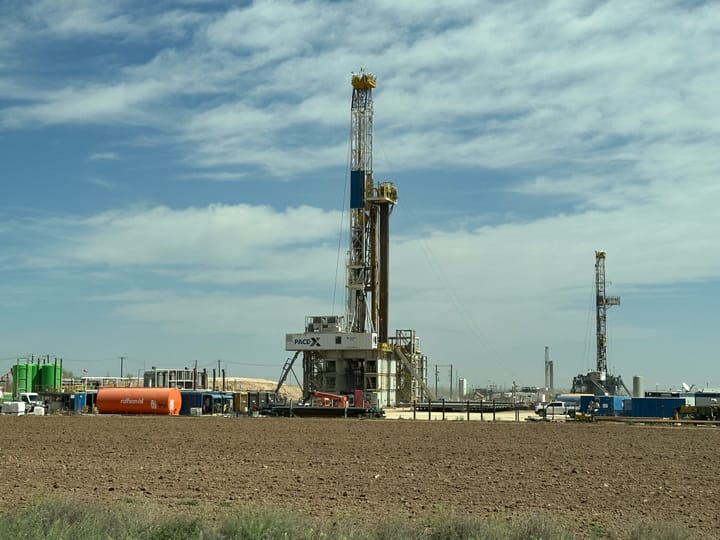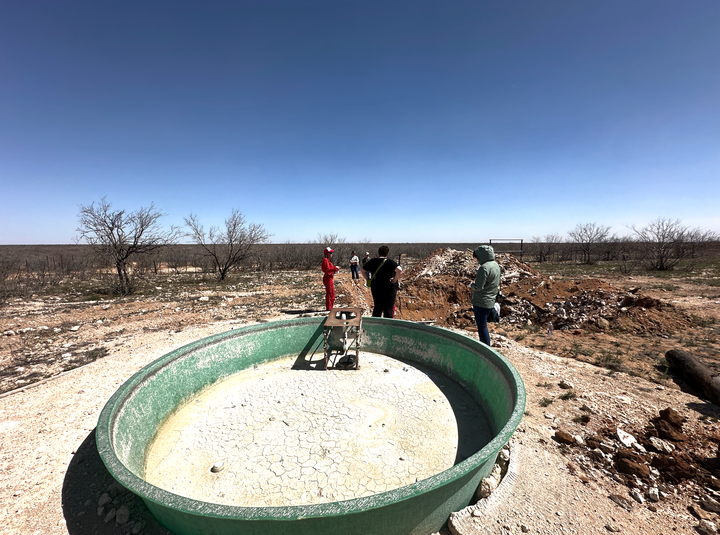Injection Wells Will Haunt Us Forever

In 1971 Orlo Childs was speaking at the annual Underground Waste Management symposium and posed the following question about the practice of using injection wells to dispose of America’s toxic waste.
“Where will the waste reside 100 years from now?” Orlo Childs at the 1971 conference Underground Waste Management symposium. “We may just be opening up a Pandora’s box.”
Orlo was on to something and it didn’t take 100 years to get an answer to his question. Earlier this month there was a 100 foot geyser of toxic water in the Texas desert. A funny thing about the West Texas desert in 2024 is the only place you see standing water of any kind is in oil-industry toxic waste water pits. Or in pretty geysers of the toxins blasting back to the surface because the Texas oil industry has tried to inject so much waste under the desert. Pandora’s box has opened. We now have the answer to Orlo’s question. Where will the waste be in 100 years? Back at the surface with its rightful owners.
In July I wrote, “The misguided and misinformed attempts to hide the sins of the oil and gas industry by injecting them underground don’t work.” Since then I’ve read the chapter about injection wells in Justin Nobel’s book of horror and masterclass in investigative journalism, Petroleum-238 (please buy it and support real journalism). It’s where I learned about Orlo Childs. The book is full of horrifying facts like this one, “America generates over a trillion gallons of oilfield wastewater every year, and 96 percent of that will be disposed down an injection well.”
As Nobel’s research explains, while that waste may be disposed down an injection well, no one ever really expected it to stay there. Injection wells were supposed to be a short term solution, as back in 1970 Orlo Childs and plenty of people knew it was a bad idea. However, the previous approach to hiding pollution - dumping it in rivers, had grown unpopular.
In 1970 the Cuyahoga River in Cleveland caught on fire. It wasn’t the first time but this instance made the cover of TIME magazine and people were not happy. Back then Republican leaders weren’t spending there time saying, “I’m not Hitler” and making plans to end the EPA, and this will sound like science fiction to the younger folks, but the Republican president at the time actually started the EPA which introduced the Clean Water Act that no longer allowed “the discharge of pollutants into the navigable waters.”
The industry folks like to say the solution to pollution is dilution. I expect they will likely say that again in the near future to deal with their fracking water and perhaps propose dumping it all in the ocean like they already do in offshore oil fracking operations. But, like injection wells, dumping waste in rivers was just kicking the can on the problem and it worked until it didn’t and the rivers were on fire. As Nobel reports in his book they knew injection wells weren’t a real solution to dealing with the waste in 1970 but at least the rivers would no longer be burning. “David Dominick, Commissioner of Federal Water Quality Administration (precursor to the yet to be formed EPA) said that injection wells were a short-term fix and should be used with caution and ‘only until better methods of disposal are developed.’”
They Knew
Imagine the oil industry ignoring warnings from scientists, right? Perhaps you are thinking, “But it was only a couple of scientists saying this….” It wasn’t. More from Petroleum-238
“There is always danger of subsequent contamination. If this method is used, care must be taken that the brines are delivered to a reservoir formation from which migration can not take place with detrimental effect to sources of freshwater supply.” Disposal of Oil-Field Brines (1929)
In 1929 they realized it could contaminate freshwater. Nobel also reports on comments from a 1971 talk titled “EPA - The Environmental Watchman” that said that injection wells were “a technology of avoiding problems, not solving them in any real sense…We really do not know what happens to the wastes down there. We just hope.”
The oil industry has known about these risks since 1929. They were warned that this was a temporary solution. And here we are. Freshwater supplies are being contaminated. Earthquakes are common (Nobel reports they warned of this as well). They chose a technology of avoiding problems. A “technology of avoiding problems” is also an excellent way of talking about carbon capture and storage. So let’s do that.
Carbon Capture and Storage and Chrome 13
It has been known for a long time that injection wells are not a permanent solution and that what we blast underground will come back to us. Will it take 100 years? Fifty? One? We don’t know until we try and boy have we tried. And in the case of the oil industry we can see how that is failing in the Permian in Texas. And in Ohio. And across the country where we have more than 180,000 injection wells. I wrote about some of these failures in July.
The thing about the oil industry’s plan to capture carbon and store it underground is that it only works if the storage is permanent. And yet we know that is impossible. When will we learn that blasting carbon dioxide underground is a failed strategy? Earlier this month, actually. The very first carbon storage project has already failed. We tried again, we hoped, we failed.
“The agribusiness company Archer-Daniels-Midland has paused injection of carbon dioxide at its Illinois carbon capture and storage (CCS) site after discovering a potential leak deep underground, the company confirmed on Wednesday.”
This project was storing carbon captured in ethanol production. So, this instance was using a known failed storage concept to store carbon captured from ethanol, which is a known failed climate solution. And the reason it failed is just one more example of why these industries simply can’t be trusted.
From E&E “A leak at the country’s first commercial carbon dioxide sequestration project was likely caused by corrosion of the steel used in the well, a finding by federal regulators that poses a significant risk to dozens other projects around the country planning to use the same type of metal. The steel, 13 Chrome, has been used for decades in oil and gas wells, but it appears to be vulnerable to corrosion when exposed to the liquids in carbon sequestration wells.”
Unfortunately, having covered the oil industry for the last 10 years, this sort of technical oversight comes as no surprise. Are there other steels that aren’t known to have this problem? Yes. But they are more expensive. How are they supposed to pay the CEO of ADM $24 million a year if they pay for the good steel?
The summary of the E&E story notes that the “EPA has concluded that dozens of planned [carbon storage] projects contain dangerous design flaws…”
That piece (paywalled) also notes “It is unclear how many of the pending applications at EPA included the use of 13 Chrome, but industry experts say it is likely a large proportion of them.” Remember the good steel is more expensive. Meanwhile an expert in the E&E article who has actually looked at 13 Chrome for these applications says, “We haven’t found anywhere 13 Chrome will work.”
E&E reached out to state regulators of planned carbon capture projects in North Dakota, Wyoming and Louisiana and reported that, “None of the state’s regulatory offices responded directly to questions about how they would respond to the new 13 Chrome worries when asked.” So, the industry is kicking the can once again. Cutting corners to save money to pay higher executive salaries. These are all more examples of how we push the true costs of oil and gas production onto the public. These are all indirect subsidies for the oil and gas industry. Nobel interviews oil industry workers in his book although most use pseudonyms because they know the true character of the industry. One going by Peter makes the following observation about the toxic wastewater he transported from well sites to injection wells:
“Of course it is going to get in drinking water, it’s fucking everywhere. This is the cheapest known way to get rid of a cheap product, which if it is handled right is not a cheap product.” Peter (not his real name), former frack waste brine truck driver talking about using injection wells to dispose of fracking waste.
If it is handled right, it is not a cheap product. What would our oil really cost if it included the costs to actually deal with the toxic waste and the money it will take to clean up the millions of oil and gas wells in America?
Nobel also interviews Bob, a landowner who had to deal with injected waste returning to the surface of his land.
“I am just worried about our drinking water. If it gets in our drinking water we are done. There is no known way to man and no amount of money on earth that will remove it."
When you are in a hole, it’s good to stop digging. We would be well served to listen to the advice of Bob and Peter. Or we can just open up Pandora’s box again and hope that this time, for sure, it will be different.
When I was in the Permian in March, I visited a ranch that was dealing with toxic water returning to the surface. In this video, Hawk Dunlap explains how the water table there is 40-50 below the surface. But in this water well, the water is now only 12 feet below the surface because of pressure that is forcing it up.



Comments ()